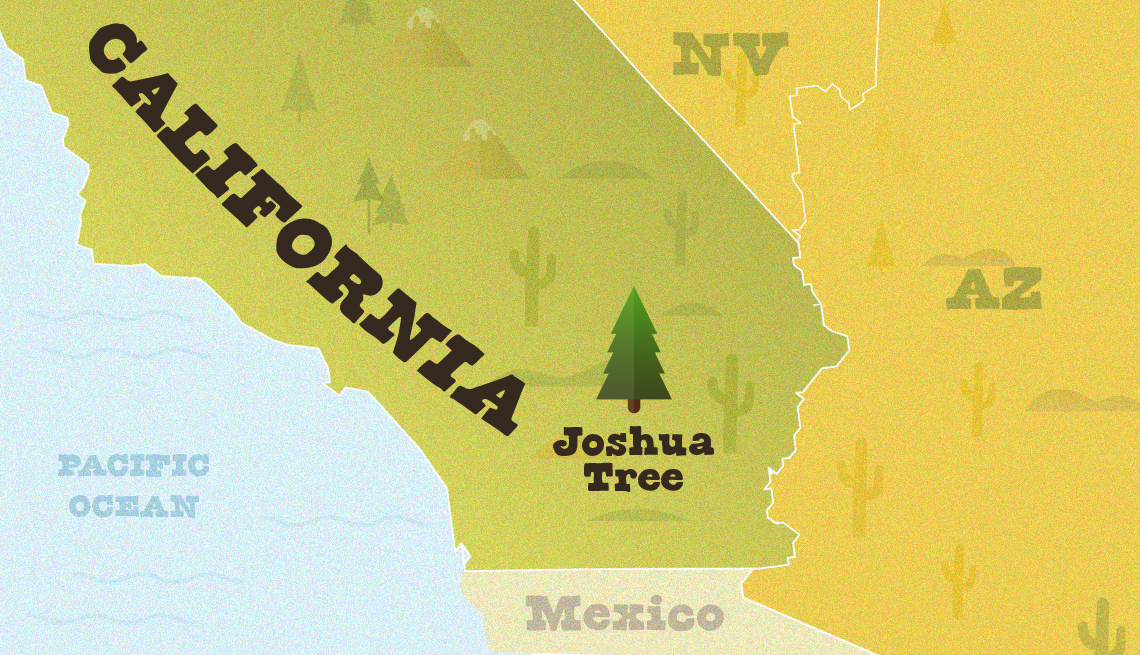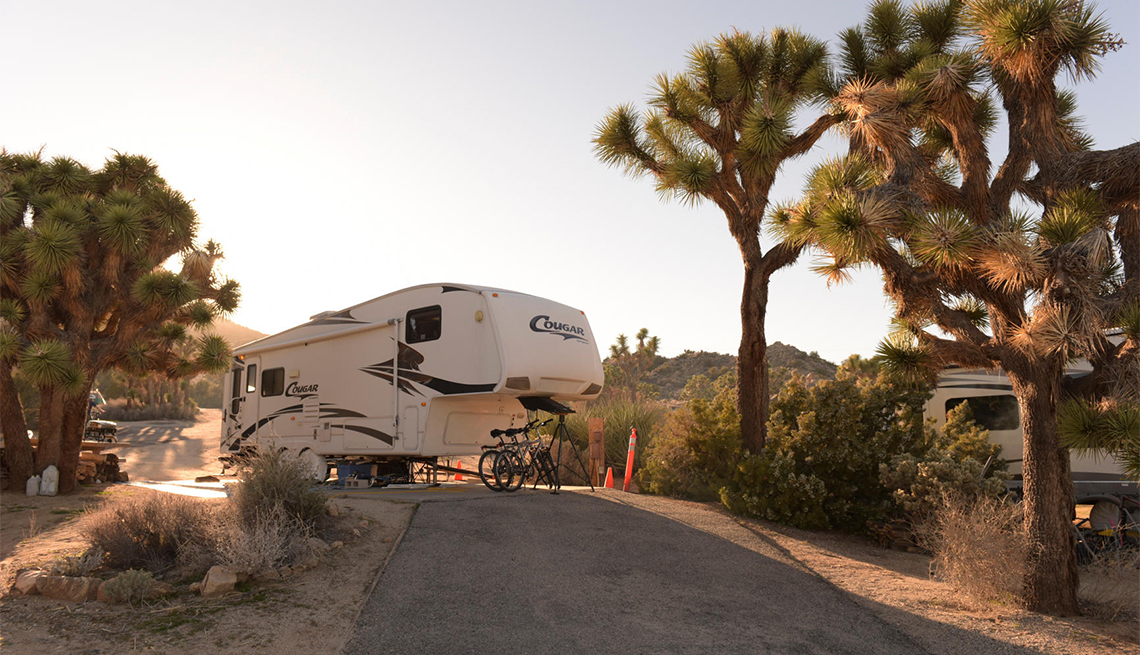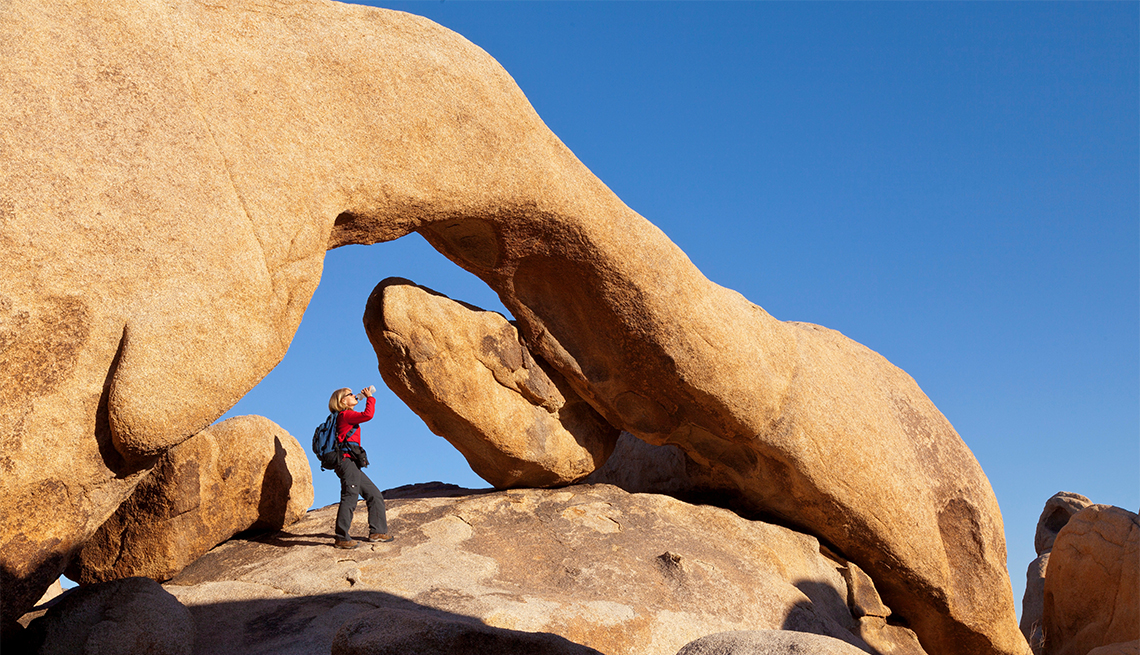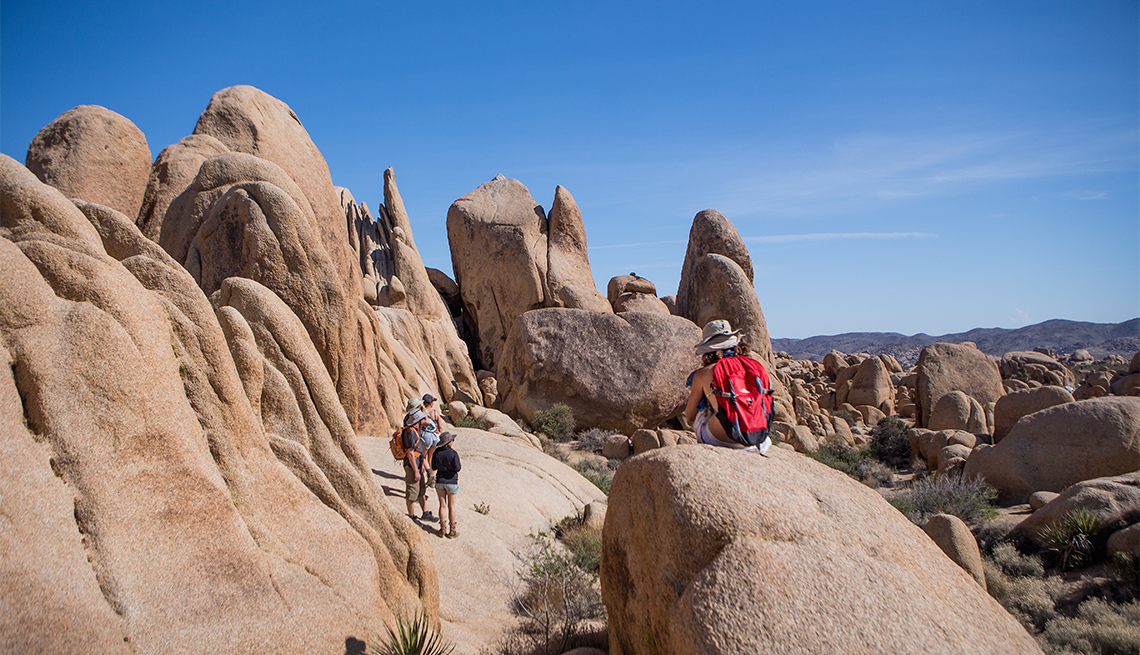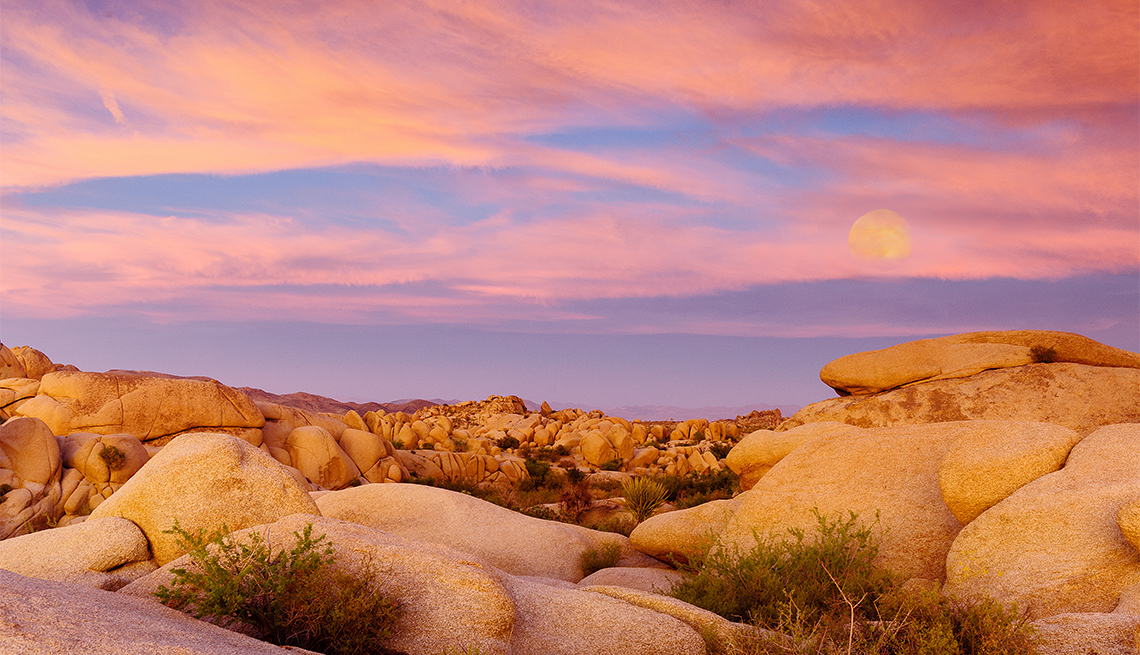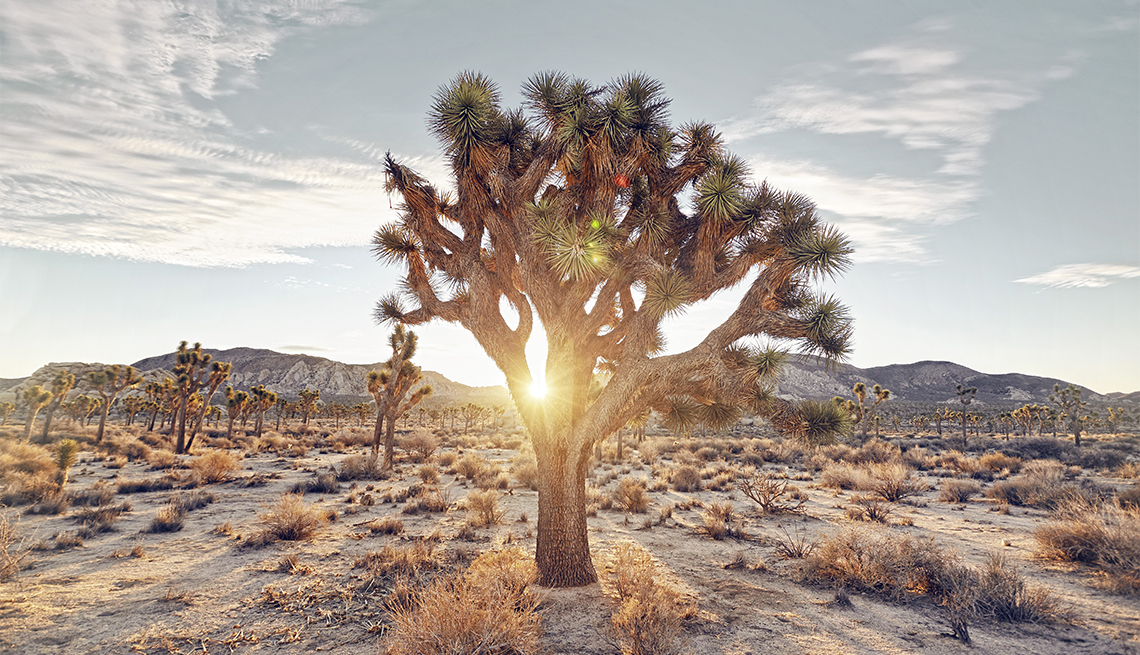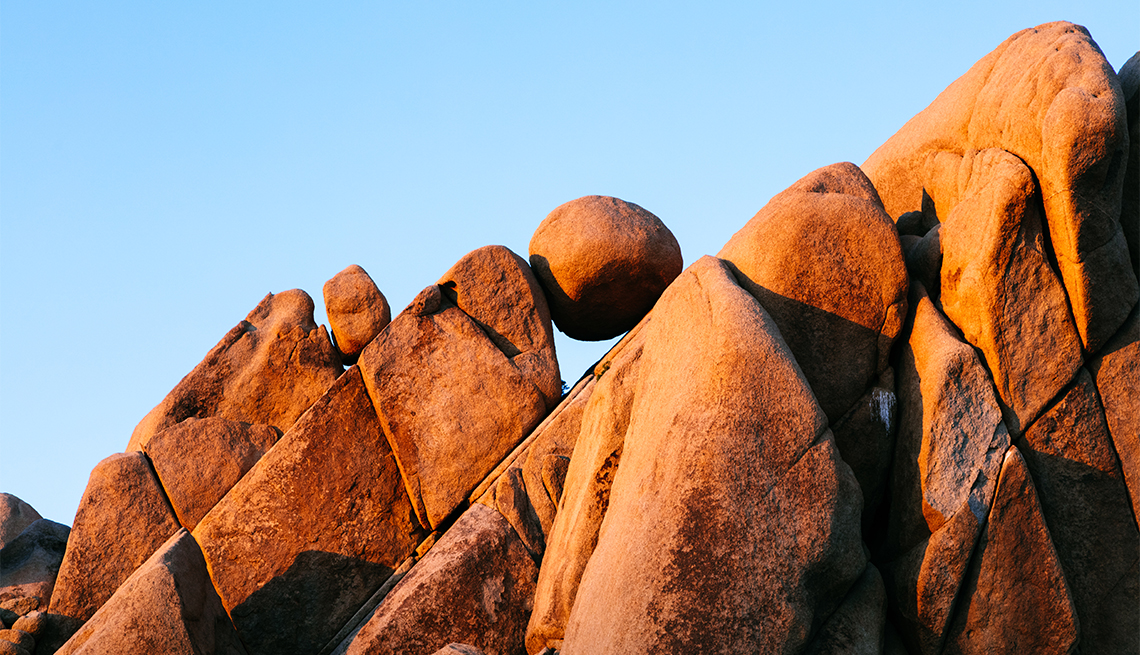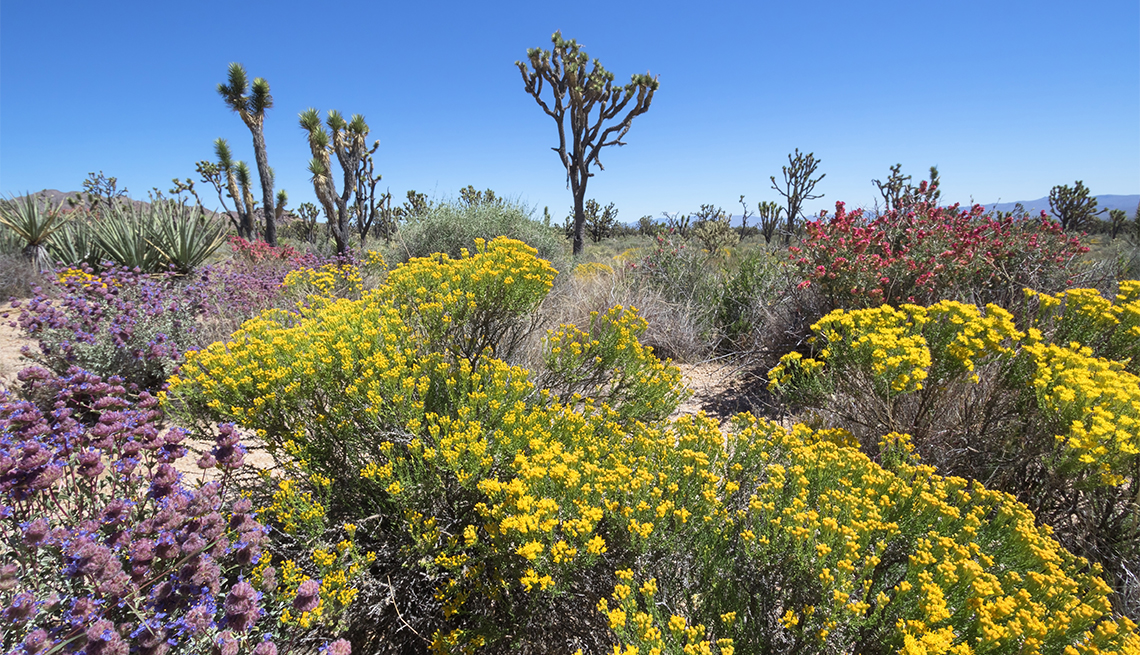All-Inclusive Guide to Joshua Tree National Park
The California haven offers a ruggedly beautiful landscape
In the scenic desert backcountry of southeast California, vibrant wildlife chirp and skitter in oases, fantastic rock formations glow under spectacular candy-colored sunsets, and a dazzling star-filled night sky illuminates campgrounds. Across the rolling hills, a legion of Joshua trees, Yucca brevifolia, seems to beckon visitors with their limbs raised to the heavens.
Joshua Tree National Park’s (JTNP) eponymous trees, which brought this unique landscape its well-deserved fame, have captured visitors’ imaginations since the native Serrano and Chemehuevi peoples painted pictographs of the flora centuries ago. Mormon pioneers en route to California in the 1850s are said to have nicknamed the trees in honor of Joshua raising his hands in prayer and pointing the way to the promised land. Explorer John Fremont, less impressed, described the Joshuas as “the most repulsive trees in the vegetable kingdom.” The band U2, inspired by the Joshua trees’ noble resilience amid harsh conditions, named its best-selling album after the hardy plant.
It’s well worth visiting this national park not only for the trees, but to fully explore the unique ecosystems at the edges of the Mojave and Colorado deserts. Plus, fun activities range from bird-watching, rock climbing and stargazing to simply going for a short scenic roadside walk or drive across the changing landscape. It’s the park’s minimalist beauty that Ranger Sarah Jane Pepper emphasizes when she says “Joshua Tree is a fun place to go, but we’re definitely not like Yosemite or Grand Canyon. It’s a very primitive park, with no hotels or restaurants or things like that. But that’s what I love about Joshua Tree.”
JTNP finally earned national park status in 1994 after languishing as a lesser-protected national monument for nearly six decades due to developer and mining interests. This beautiful but harsh landscape attracts more than 2 million visitors annually, given its proximity to Los Angeles and the nearby tourist haven of Palm Springs.
Location: Southeast California, about 140 miles east of Los Angeles
Acreage: About 800,000 acres, with 75 percent of it designated Wilderness
Highest peaks, lowest valley: 5,814 feet elevation atop Quail Mountain to 536 feet above sea level at the park’s southeast boundary
Miles of trails: 191, ranging from wheelchair-accessible to very challenging
Main attraction: The unique desert landscape featuring rock formations and the eponymous Joshua trees
Entry fee: $30 for cars (Annual Senior Pass, $20 for 62 and older)
Best way to see it: Sunrise or sunset at one of the many roadside rock formations
When to go to avoid the crowds: Weekdays in spring and fall
Plan Your Trip
JTNP is located about 140 miles east of Los Angeles and 220 miles west of Phoenix, just off Interstate 10. From Palm Springs International Airport, it’s about a 50-mile drive to the park’s main entrances, while much of the resort community is just over a half hour’s drive away.
The park spans 800,000 acres, bounded by California Highway 62 to the north and I-10 to the south. You can access the park via four entrances off Highway 62: Going from west to east, the Black Rock Campground entrance, the West Entrance Station at the town of Joshua Tree, the Indian Cove Campground entrance, and the North Entrance Station by Twentynine Palms. Be aware that the two campground entrances don’t connect to the park’s main roads. From the park’s southern entrance, it’s a longer drive to the central campgrounds and trails.
Visit the park’s four visitor centers for free maps and brochures, as well as nature exhibits, toilet facilities and bookstores with souvenirs. You’ll find the Joshua Tree Visitor Center in Joshua Tree town, the Oasis Visitor Center in Twentynine Palms, the Black Rock Nature Center (open only from October through May) near the campground on the park’s western edge, and the Cottonwood Visitor Center near the southern entrance.
To get the full park experience, traverse JTNP on the 60 miles of roads connecting the northern and southern entrances — you’ll not only be able to tour the main central circuit around rock formations, hiking trails and expanses of Joshua trees, but you’ll get an overview of the changing desert ecosystems and elevations between the Mojave Desert in the park’s northern part (with Joshua trees) and the Colorado Desert in the south (no Joshua trees, but with plenty of other unique flora, such as the green-barked paloverde trees and the red-orange flowered chuparosa “hummingbird bushes.”)
It’s possible to get the gist of the park in a single day’s drive-through, but to really appreciate it, you should plan at least an overnight stay to take in the sunset, starry night sky, and then sunrise the next morning. Better yet, spend a few days to hike to desert oases and mountain viewpoints, while also sampling local history, food and art in gateway towns. As Park Information Officer Jennifer Albrinck says, “I’ve worked here for eight years, and I’m still discovering new things about the park every day.”
While JTNP’s extreme desert environment (temperatures can top 120 degrees in summer and drop below freezing on winter nights) can create challenges for visitors, you can enjoy the park year-round with a little planning and preparation. In summer, do like the native animals do and focus your activity in early morning and evening when temperatures are more reasonable. Visit in spring for more moderate temperatures (highs in the 70s, lows in the 40s to 50s), flowering plants and migrating birds. Fall also pleases with moderate temperatures and sparse crowds. Winter means cooler days, and campers should be aware of sometimes freezing desert nights. And the winter holiday season attracts large crowds from nearby Los Angeles, so reserve lodging far in advance. Midday can pose a challenge year-round, so be sure to respect park warnings, and bring plenty of water and sunscreen.
Regardless of the time of year you visit, remember that this is a desert park with limited services, so plan accordingly. The park has no food or gas within its boundaries, and only entrances and a couple of campgrounds provide spigots with potable water. Cellphone access is limited or nonexistent, so be sure to pick up paper maps at the visitor centers and entry gates.
Where to Stay and Eat
Lodging in and around JTNP comes in three main categories: camping within the park, affordable hotels and motels in adjacent towns, and luxury resorts in the Palm Springs/Palm Desert area, about 40 miles southwest of the park. Many of these options can be sold out during busy winter weekends and holiday seasons, but planning and flexibility can still get you prime locations and good deals.
Camping
There’s nothing quite like desert camping under JTNP’s incredibly starry night skies, being awakened to colorful sunrises and greeting the morning with an al fresco breakfast, then ending the day in camp for a spectacular sunset. For this reason, the 500 campsites across JTNP’s nine campgrounds often get filled on weekends and holidays. You can reserve (recreation.gov) six of the campgrounds (Black Rock, Cottonwood, Indian Cove, Jumbo Rocks, Ryan and Sheep Pass) six months in advance for $20 to $25 per night ($50 for group sites). The other three (Belle, Hidden Valley, White Tank) are first come, first served for $15 per night — and you’ll need to arrive early to get a spot during busy times. All nine can accommodate RVs.
The Black Rock (99 sites) and Cottonwood (62 sites) campgrounds are the only ones with running water, flush toilets and RV dump stations, so they usually get booked especially quick. Given that Black Rock sits at 4,000 feet elevation in the park’s northwest corner, expect cooler temperatures than at those in lower elevations. It has a designated area for campers with horse trailers, and you can easily make quick shopping runs to the town of Yucca Valley, just five miles away.
Wilderness camping is free with registration, but be hyperaware of your water supply and the weather conditions before entering the backcountry.
Nearby lodging and dining
Joshua Tree town (five miles northwest of the West Entrance Station)
Lodging: Fancy retro camping comes to the area late this year with the opening of Autocamp, where guests can settle into 47 luxury custom Airstream Trailers. But if you’re traveling with your own accommodations (meaning an RV), a good option 25 miles southwest of Joshua Tree is the KOA Campground in Desert Hot Springs. It has 260 RV sites with hookups, plus 26 tent sites and five cabins, and a slew of family-friendly amenities, including a laundry, miniature golf, pickleball courts, playground, pool with a café, social clubhouse and store.
Dining: In Joshua Tree town, start your day with a hearty breakfast at JT Country Kitchen, perhaps ordering banana French toast or gravy-covered biscuits. For lunch, Crossroads Cafe serves thick sandwiches, including Reubens and eggplant parmesan. Come dinnertime at the Joshua Tree Saloon, live music accompanies home-cooked barbecue in “The Yard.”
Twentynine Palms (five miles north of the North Entrance Station)
Lodging: The 83-room Best Western SureStay Plus appeals with its prime location just a few minutes from the park, good deals, free breakfasts and a large, palm-shaded pool with Jacuzzi.
Dining: Fuel up before a hike with croissants, pastries and sandwiches at the Campbell Hill Bakery. For dinner, Kitchen in the Desert serves up mesquite-grilled Trinidadian chicken in an art-gallery setting.
Note: The south entrance has no adjacent food or lodging, but driving 30 miles west on I-10 will bring you to Indio, the easternmost section of the Palm Springs resort communities.
Palm Springs
Lodging: Seek out the communities around Palm Springs for upscale resorts such as the 244-room Ritz Carlton in Rancho Mirage, which pampers guests with its cliff-top views, golf course access, Kids’ Club, pools and spa. In Palm Springs, the expansive La Quinta Resort & Club, a Waldorf Astoria Resort, delivers an old-school Hollywood vibe (from its origins in 1926) with top-notch service and facilities across nearly 800 rooms, suites and villas housed in beautiful Spanish mission-style buildings.
Dining: At Miro’s in downtown Palm Springs, dine on pan-European cuisine (Budapest Schnitzel, Shrimp and Scallops Provençal) in a Mediterranean-themed interior or a romantic patio setting. The restaurant also earns high marks for its extensive wine list. For more casual quick bites, head to John’s, a popular diner just north of downtown that serves breakfast all day, gourmet burgers, fried chicken and rib specials.
Things to Do
Hike: JTNP’s 191 miles of trails range from easy (but only a few wheelchair-accessible) to challenging ones for the physically fit that should be hiked only under cool conditions and with proper supplies, including plenty of water, sunscreen, hat and light clothing. One or two park visitors perish from heatstroke nearly every year, so take warnings seriously. But don’t let the extreme midday heat and desert conditions deter you from hikes — early morning and evening strolls can be downright pleasant, even becoming chilly in winter.
Stroll the easy Oasis of Mara pathway outside the Twentynine Palms visitor center for a good introduction to the desert. It’s a flat, paved, half-mile loop that’s wheelchair-accessible. The Hidden Valley Trail, a one-mile loop in the park’s center, traverses terrain said to be once used by rustlers who hid stolen cattle behind the canyon’s massive boulders. See the park’s spooky side along the 1.7-mile Skull Rock Trail (with its Instagram-ready namesake boulder) in the south-central part of the park.
For more of a challenge, tackle the moderate Mastodon Peak Trail, which climbs 375 feet over three miles at the park’s southern edge. On Ryan Mountain, set out on a three-mile trek up and back from a 1,000-foot peak in the park’s center for spectacular views. Insider tip: Hit this trail to watch the sunset — just don’t forget your flashlight for the return hike. If you’re really adventurous, try the new 12-mile Long Canyon Trail from Desert Hot Springs through JTNP and the recently created Sand to Snow National Monument, ending on the park’s western edge.
Go rock climbing: JTNP’s towering granite rock formations have made the park a world-renowned rock climbing destination, with thousands of named routes attracting elite climbers and novices alike. “Rock climbing is accessible to anyone. We have regular rock climbers in their 80s who come here,” says Albrinck. Many of the sheer 200-foot climbing routes are only for well-trained, well-equipped climbers, but local guiding companies such as Cliffhanger Guides and Stone Adventures lead safely managed day trips for beginners.
But you don’t need equipment or training to enjoy clambering up, down and around smaller rock formations, this being a natural playground popular with kids and adults alike. The Hidden Valley and Jumbo Rocks areas in the park’s center have dozens of 5- to-10-foot-tall rocks to jump around. And despite the “Hall of Horrors” name, this boulder-created half-mile trail in the park’s center is more of a funhouse tour of rock outcroppings and tiny alcoves than anything scary.
Stargaze: With its dry air, higher elevation and distance from major cities, JTNP is a certified “dark sky” destination, making it one of the best places in the world (and certainly in Southern California) to stargaze. With the park’s clear skies, the Milky Way looks milky, meteor showers appear close enough to touch and constellations are as bright as kids’ dot-to-dot books. A moonless night in the park’s more remote wilderness (away from the light of campgrounds) is the prime time and place to stargaze, but shining stars will dazzle you even in a crowded campground. Ranger Pepper recommends the Echo T parking lot (just off the main road near Hidden Valley) for photographing stars with silhouetted Joshua trees and rock formations. The Joshua Tree Astronomy Arts Theater in the town of Joshua Tree and the Sky’s the Limit Observatory and Nature Center in Twentynine Palms both host astronomy lectures and lead stargazing sessions.
Go bird-watching and take nature tours: More than 250 bird species fly through the park, including 78 native species that nest in JTNP’s green oases and desert habitats. Cottonwood Spring, the Oasis of Mara and the Smith Water Canyon are top locations to spot cactus wrens, local doves and mockingbirds, with falcons and hawks circling high in the sky. Quail and roadrunners trot around the scrub throughout the park year-round. During the spring migratory season, you can see colorful buntings, tanagers and warblers, along with ominous flocks of turkey vultures. Guides from the Big Morongo Canyon Preserve, adjacent to the park, make it easier to seek out and identify many of these small birds. Or sign up for any of the excellent educational tours offered by the nearby Desert Institute.
Gateway towns
On JTNP’s northern edge, stock up on camping supplies, overnight in a motel or grab pre- and post-visit meals in the towns of Joshua Tree and Twentynine Palms. Also take in the towns’ artsy vibes. The curious Noah Purifoy Outdoor Desert Art Museum north of Joshua Tree looks like a postapocalyptic sculpture garden creating art from found objects. Twentynine Palms’ “Oasis of Murals” depicts desert wildlife, history and culture on two dozen walls around town. You can also tour more conventional art galleries and antique stores in both towns. At Pioneertown on the outskirts of Joshua Tree, treat yourself to a thrill watching staged gunfights, then go to Pappy and Harriet’s Pioneertown Palace to hear live music and chow down on a Cowboy Combo of barbecue chicken, ribs and steak.
You won’t find a gateway town at Joshua Tree’s southern entrance; rather, it’s about 30 miles from there to the eastern edge of the Palm Springs/Palm Desert/Indio resort communities.
En Route
The Palm Springs area, including Palm Desert and Ranch Mirage, has long been a popular vacation destination for Los Angeles residents, as well as visitors from across North America via the Palm Springs International Airport. In addition to art galleries, boutiques, fine dining, golfing and luxury resorts, the area entices with outdoor activities that can complement a trip to JTNP. Aboard the Palm Springs Aerial Tramway, ride up to the 8,516-foot summit of Mountain Station for spectacular views over the desert region. Go hiking on the 1.8-mile Tahquitz Canyon Trail (mostly paved but with some steep steps), which leads to a seasonal 60-foot waterfall — quite a desert surprise. At the Palm Springs Air Museum see (and even fly in) World War II and more recent combat aircraft preserved well in the dry desert climate.
- |
- Photos
AARP Membership -Join AARP for just $12 for your first year when you enroll in automatic renewal
Join today and save 25% off the standard annual rate. Get instant access to discounts, programs, services, and the information you need to benefit every area of your life.


